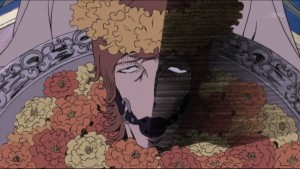The curious responses to Fujiko’s ending says a lot about otaku culture on the whole, especially certain comments about Fujiko’s virtue. And some reviewers feel that turning the male gaze inward isn’t confronting the male gaze in a sufficient manner at all. These are interesting discussions and that individuals are turning to these themes while talking about Fujiko says a lot about its power to entertain and educate.
But that’s not what I’m here to talk about, what I’m here to talk about are the rising peaks of femininity…
All right, all right and Fujiko’s further engagement with literature of a different type. But while we’re focused on glorious boobs, let’s talk about the prevalence of nudity in the series. Our first stop is the reasoning behind Fujiko and her penchant to be naked in the opening sequence. We’ve seen by the ending how this has all worked out and clever watchers noticed that the opening theme seemed to be some kind of metaphor for the rest of the series. Let’s go past the initial response that Fujiko is a gorgeous woman and it’s extremely satisfying to the nether regions to see her disrobed, while her glorious breasts heave in a landscape of personal struggle. Sexuality is part of Fujiko’s character, and you can track the series by the stylization of her breasts from Mamo to the Pink Jacket. The only place you don’t really see her perversity is in Miyazaki’s gentle side-stepping of her sexual nature. Although her boobs are absurdly enormous, we don’t really see her in full seductress mode in Cagliostro. It’s easy to look at Miyazaki and instantly write off Fujiko’s contribution but I think there is something to be said in the way some men deal with women’s sexuality – by keeping their clothes on and their legs firmly shut.
This is also not so coincidentally one of the largest discussions in feminist history and has been going on since the dawn of feminism itself. Extremely simplified this discussion amounts to; what is the woman’s body, who has the right to use it and for what purpose.
::::: SPOILERS AHEAD ESPECIALLY CONCERNING THE ENDING :::::
While I admire Miyazaki and his desire to turn women into something other than sex symbols I’m not sure if cutting off anyone’s genitals, child or not, is an entirely healthy thing. The Fujiko in our current series is something I find absolute stunning both visually as a beautiful woman and mentally as a glorious representation of woman’s freedom. The exposing of her body at key points during the series is both amazingly beautiful but also an implication and you see this most in episode 9. If you didn’t notice the smaller details in that episode, let me help you out.
Geishas. A Japanese traditional sign of the patriarchy getting teased and manhandled by foreign men.
A woman who is an infant mentally being bought and sold via a TV screen. Welcome to painful metaphors for modern living.
The circus fair a Japanese traditional scene for the Camellia girl, another popular culture trope for a girl’s sexual and psychological exploitation.
And Fujiko, losing her shit because to reconcile with the sexual past supplanted in her mind, she must kill herself.
That last bit is prevalent in so much literature geared towards women it has become a trope of itself that I can’t help but cheekily call ‘the slut suicide’. Destruction of virtue is implied as the destruction of worth, and if you aren’t convinced just recall what certain otaku proclaim after it comes out their beloved waifu’s ever touched another man. The gothic romantic exploits this in numerous ways as does traditional literature but the difference between other literature and the matured gothic romantic is that we’re supposed to feel sorry for the woman who suffers, instead of judging her as worthlessly perverse with only one dignified fate left for her to coldly embrace.
And while your skin is hopefully crawling with disgust, let’s confront the finale head on that so many people had issue with. Fujiko is not a slut because of a disturbing past, she’s a slut because she likes it. And that is the essence of the argument surrounding sympathy for or against Fujiko. And for or against the very idea of self possessed womanhood.
But what struck me the most about the ending and the part that will linger, is the unmasking of the owl. It was a woman all along, and doesn’t that say something about the rotten comments about how often Fujiko is naked from other women; the slut shaming and judgement from people of our own gender, and the female misogyny that women encounter every day. Because the number one enemy of woman’s progress towards independence isn’t the father or brother or lover, but women themselves. We see it in traditional repression, in the way daughter’s are raised, and at work when a woman in power marginalizes and treats poorly the younger, more attractive co-worker. And in the gothic romantic tradition, nothing is so heart wrenching than the evil women who are most often victims themselves flitting around the heroine, causing her despair, destruction and grief because of their own unfulfilled ambitions. Fujiko’s confrontation of her fabricated past is like confronting the real past of women’s nature being defined by the shadow of a patriarchy that is slowly dying. And still, those horrifying shadows linger in our society through tradition and culture maintained by an older generation too unaware of it, just as Aisha is longing for a freedom impossible to have and projecting a nightmare onto another woman. The decrepit lolita is like the decrepit remains of a patriarchy that women already have the ability to shove off, if it weren’t for deeply engrained constructs.
Perhaps the most revealing moment of the entire series is when Fujiko, in what appears to be an act of masochism, casts off the yolk of a fake and fabricated past that was real to her only as a history of experiences and Aisha under the halo of a mysterious light, is finally at peace.
There is a lot to discuss in Fujiko and this series has barely nudged the surface. Oscar for one, is someone who deserves his own post and a discussions of his own tropes, and it’s something I’ll endeavour to cover in the future since I love the kid and feel a bit sad he so often gets maligned. I hope that readers have at least used these posts as a starting point in their own critical discussions of not just Fujiko but anime on the whole. As a genre that is rich with tropes, cultural curiosities and artistic talent, it’s a type of popular culture that deserves deeper scrutiny. Fujiko is absolute genius because it has a male audience unused to flowery tropes and love literature who have appeared due to Lupin, but then an entirely different audience more sensitive to women’s literature and desires has also arrived to clash with any preconceived dialect concerning Fujiko herself. A great series goes beyond its genre limitations and brings together culture and conversations that wouldn’t appear otherwise and it’s arguably a hallmark of the great literature we’ve already talked about. The Lupin fan meets the shoujo fan meets the yaoi fan, and the culture clash has been spectacular to behold. But above everything else, Fujiko has given new life to a much older series that had almost run itself into the ground with predictability, and garnered an enormous number of fans that might not have shown up if it weren’t for Okada’s sensitive treatment of the typical Bond girl.
And personally I can’t deny being affected. Recently I went back to the 70′s Lupin which I had seen many times before. When Fujiko came onscreen, I used to groan aloud.
























